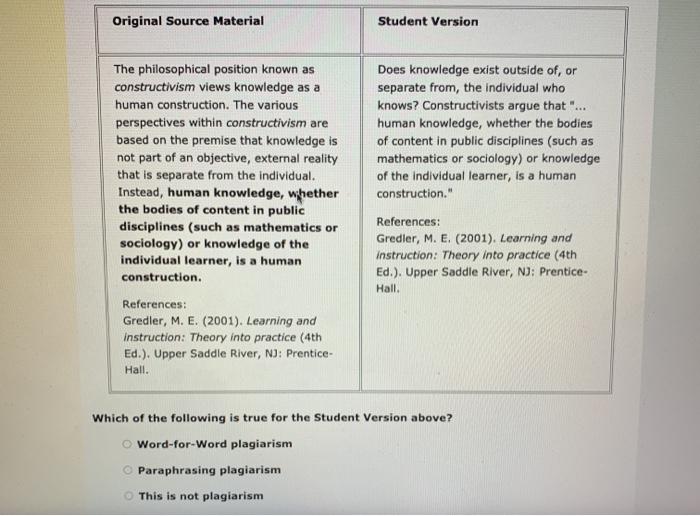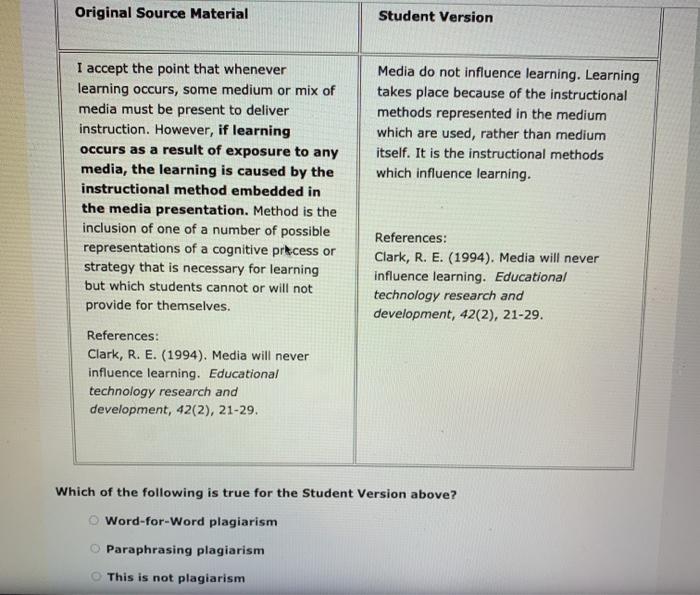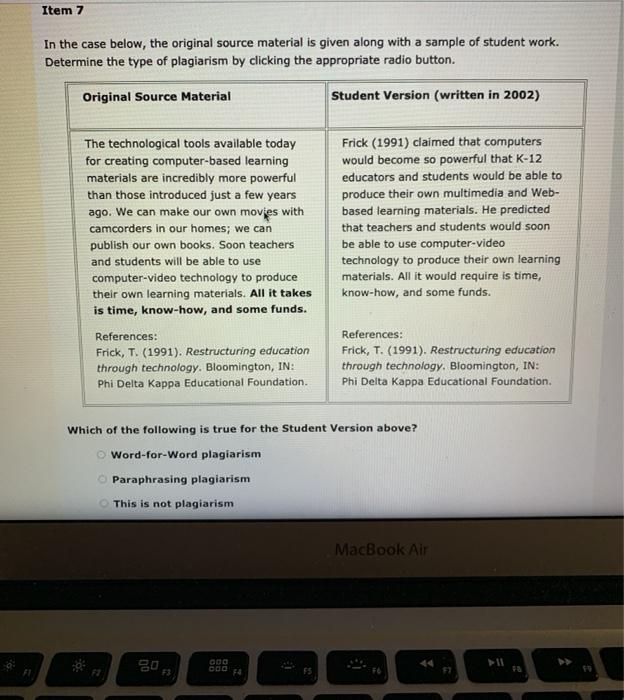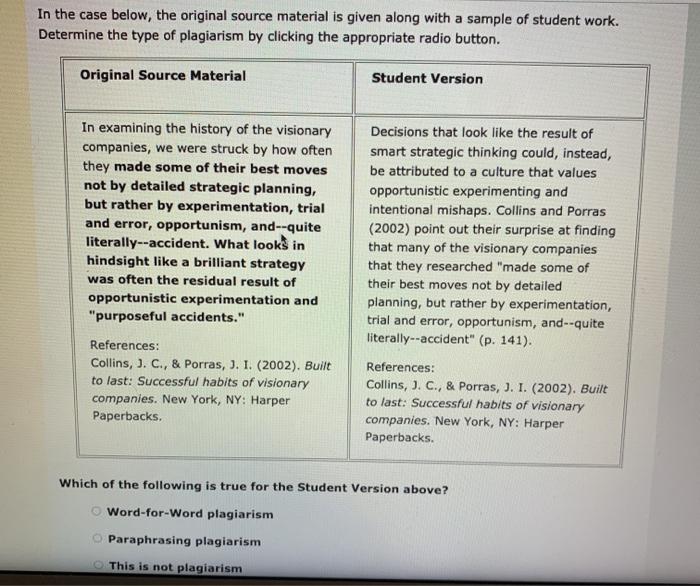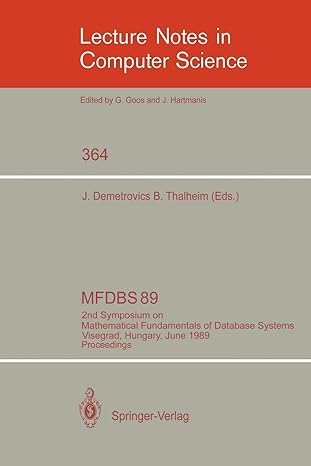help please!

In the case below, the original source material is given along with a sample of student work. Determine the type of plagiarism by clicking the appropriate radio button. Original Source Material Student Version Merck, in fact, epitomizes the ideological nature--the pragmatic idealism--of highly visionary companies. Our research showed that a fundamental element in the "ticking clock" of a visionary company is a core ideology--core values and a sense of purpose beyond just making money--that guides and inspires people throughout the organization and remains relatively fixed for long periods of time. Several factors can contribute to long- term organizational success. One is the establishment of a core ideology that Collins and Porras (2002) describe as "core values and sense of purpose beyond just making money" (p. 48). Also, the importance of a visionary leader that guides and inspires people throughout the organization and remains relatively fixed for long periods of time is hard to over emphasize. References: Collins, J. C., & Porras, J. 1. (2002). Built to last: Successful habits of visionary companies. New York, NY: Harper Paperbacks. References: Collins, J. C., & Porras, J. I. (2002). Built to last: Successful habits of visionary companies. New York, NY: Harper Paperbacks. Which of the following is true for the Student Version above? Word-for-Word plagiarism Paraphrasing plagiarism This is not plagiarism Original Source Material Student Version Does knowledge exist outside of, or separate from, the individual who knows? Constructivists argue that "... human knowledge, whether the bodies of content in public disciplines (such as mathematics or sociology) or knowledge of the individual learner, is a human construction." The philosophical position known as constructivism views knowledge as a human construction. The various perspectives within constructivism are based on the premise that knowledge is not part of an objective, external reality that is separate from the individual. Instead, human knowledge, whether the bodies of content in public disciplines (such as mathematics or sociology) or knowledge of the individual learner, is a human construction. References: Gredler, M. E. (2001). Learning and instruction: Theory into practice (4th Ed.). Upper Saddle River, NJ: Prentice- Hall. References: Gredler, M. E. (2001). Learning and instruction: Theory into practice (4th Ed.). Upper Saddle River, NJ: Prentice- Hall. Which of the following is true for the Student Version above? Word-for-Word plagiarism Paraphrasing plagiarism This is not plagiarism Original Source Material Student Version Media do not influence learning. Learning takes place because of the instructional methods represented in the medium which are used, rather than medium itself. It is the instructional methods which influence learning. I accept the point that whenever learning occurs, some medium or mix of media must be present to deliver instruction. However, if learning occurs as a result of exposure to any media, the learning is caused by the instructional method embedded in the media presentation. Method is the inclusion of one of a number of possible representations of a cognitive process or strategy that is necessary for learning but which students cannot or will not provide for themselves. References: Clark, R. E. (1994). Media will never influence learning. Educational technology research and development, 42(2), 21-29. References: Clark, R. E. (1994). Media will never influence learning. Educational technology research and development, 42(2), 21-29. Which of the following is true for the Student Version above? Word-for-Word plagiarism Paraphrasing plagiarism This is not plagiarism Item 7 In the case below, the original source material is given along with a sample of student work. Determine the type of plagiarism by clicking the appropriate radio button. Original Source Material Student Version (written in 2002) The technological tools available today for creating computer-based learning materials are incredibly more powerful than those introduced just a few years ago. We can make our own movies with camcorders in our homes; we can publish our own books. Soon teachers and students will be able to use computer-video technology to produce their own learning materials. All it takes is time, know-how, and some funds. References: Frick, T. (1991). Restructuring education through technology. Bloomington, IN: Phi Delta Kappa Educational Foundation. Frick (1991) claimed that computers would become so powerful that K-12 educators and students would be able to produce their own multimedia and Web- based learning materials. He predicted that teachers and students would soon be able to use computer-video technology to produce their own learning materials. All it would require is time, know-how, and some funds. References: Frick, T. (1991). Restructuring education through technology. Bloomington, IN: Phi Delta Kappa Educational Foundation. Which of the following is true for the Student Version above? Word-for-Word plagiarism Paraphrasing plagiarism This is not plagiarism MacBook Air FT In the case below, the original source material is given along with a sample of student work. Determine the type of plagiarism by clicking the appropriate radio button. Original Source Material Student Version In examining the history of the visionary companies, we were struck by how often they made some of their best moves not by detailed strategic planning, but rather by experimentation, trial and error, opportunism, and --quite literally--accident. What looks in hindsight like a brilliant strategy was often the residual result of opportunistic experimentation and "purposeful accidents." Decisions that look like the result of smart strategic thinking could, instead, be attributed to a culture that values opportunistic experimenting and intentional mishaps. Collins and Porras (2002) point out their surprise at finding that many of the visionary companies that they researched "made some of their best moves not by detailed planning, but rather by experimentation, trial and error, opportunism, and quite literally--accident" (p. 141). References: Collins, J. C., & Porras, J. I. (2002). Built to last: Successful habits of visionary companies. New York, NY: Harper Paperbacks. References: Collins, J. C., & Porras, J. I. (2002). Built to last: Successful habits of visionary companies. New York, NY: Harper Paperbacks. Which of the following is true for the Student Version above? Word-for-Word plagiarism Paraphrasing plagiarism This is not plagiarism Original Source Material Student Version In examining the history of the visionary companies, we were struck by how often they made some of their best moves not by detailed strategic planning, but rather by experimentation, trial and error, opportunism, and quite literally accident. What looks in hindsight like a brilliant strategy was often the residual result of opportunistic experimentation and "purposeful accidents." The variety of projects that Google undertakes, from Internet search to cars that drive themselves, could be considered lack of focus. However, perhaps Google recognizes that successful moves that looked like the result of "a brilliant strategy was often the residual result of opportunistic experimentation" (Collins & Porras, 2002, p. 141). References: Collins, J. C., & Porras, J. 1. (2002). Built to last: Successful habits of visionary companies. New York, NY: Harper Paperbacks. References: Collins, J. C., & Porras, J. I. (2002). Built to last: Successful habits of visionary companies. New York, NY: Harper Paperbacks. Which of the following is true for the Student Version above? O Word-for-Word plagiarism Paraphrasing plagiarism This is not plagiarism


